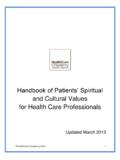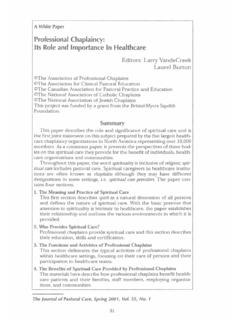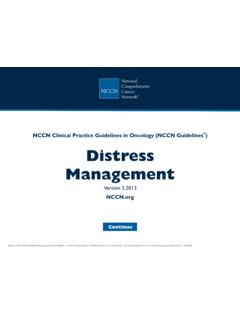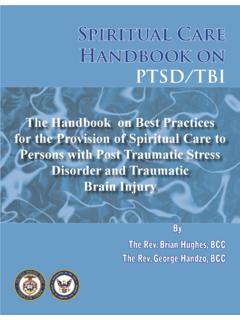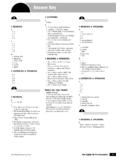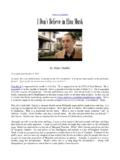Transcription of Discerning Patient Needs: Spiritual Assessment ...
1 Edition 4 of a Series Discerning Patient needs : Spiritual Assessment Perspectives for Health Care Chaplains Series Editor: P Scott Richards Counseling Psychology and Special Education, Department of Education, Brigham Young University I. Rationale Despite growing professional awareness of the importance of religion and spirituality in health and human welfare, patients religious backgrounds and spirituality may be overlooked by physicians, nurses, psychologists, and other health care professionals.
2 Chaplains can fulfill a crucial role in health care settings by making sure that patients Spiritual beliefs and needs are carefully assessed and fully understood. This information may prove valuable for all members of the health care team. By understanding patients Spiritual worldviews, health care professionals are better able to empathically understand them. Spiritual Assessment can also help health care professionals determine if clients have unresolved Spiritual concerns or needs . Physical healing and psychological coping may be complicated if patients are experiencing Spiritual distress.
3 Appropriately addressing patients Spiritual concerns and needs can contribute to more rapid recovery and better prognosis. A Spiritual Assessment can also help health care professionals identify patients whose Spiritual and psychological distress is sufficiently severe and persistent as to warrant referral for longer-term professional help after hospital discharge. A number of potentially useful religious- Spiritual Assessment strategies and methods have been described in the professional literature. This bibliographic series introduces chaplains to this literature. Ultimately, for health care professionals who believe that human beings may receive enlightenment and inspiration from the divine, a Spiritual Assessment may be more than just conceptualizing information that has been gathered in intake questionnaires, clinical interviews, and objective or projective Assessment measures.
4 A Spiritual Assessment may also include prayerful or meditative efforts to seek Spiritual impressions and insights about patients and their problems and how to assist them. 1 II. Three-Five of the Best Books or Articles The first entry summary and commentary on Fitchett and the second on Fitchett and Risk are reprints from Reverend George Handzo s By Its Fruits: The Science of Health Care Chaplaincy in Practical Bearings: The Critical Bibliography for Health Care Chaplains, Vol. 1, No. 1, (February, 2009). The first three books/articles in this section were written by pastoral professionals for pastoral professionals and have direct relevance to the work of chaplains.
5 The second two chapters/articles were written for primarily for physicians, but they are included because they provide much insight that is of importance to health care chaplains. Fitchett, G. (1993) Assessing Spiritual Need: A Guide for Caregivers. Minneapolis, Minnesota: Augsburg/Fortress Press. Summary George Fitchett presents a model for Spiritual Assessment that he and his colleagues developed, as illustrated with case studies. This 7X7 model has become a classic from which many other models are derived. He reviews three other models and provides a framework for evaluating them.
6 The framework includes the model s concept of spirituality, norms and authority, and Assessment context and process. The models include Paul Pruyser s The Minister as Diagnostician, Elizabeth McSherry s work at the Veterans Administration, and the model of the North American Nursing Diagnostic Association. This book addresses many of the questions pastoral caregivers have raised about this timely and enduring topic and provides an informed and balanced approach for making decisions about Spiritual Assessment models and tools. Comment Good Assessment needs to be the cornerstone on which all of pastoral care delivery is built.
7 It drives the plan of care, interventions, and outcomes. It surfaces the facts that communicate to other disciplines what chaplaincy does. As a side note, it is important to distinguish Spiritual screening, which any staff person can do, and Spiritual Assessment , which should be the prerogative of the professional chaplain. Many chaplains have avoided doing Assessment because professional pastoral care does not have a standard method. All chaplains need to realize that what is most important is to have a system that becomes standard for them and for their colleagues in a given institution so that other disciplines come to understand what they are doing.
8 2 Fitchett, G., & Risk, J. Screening for Spiritual Risk. Journal of Pastoral Care & Counseling. In Press. Summary For years George Fitchett has been the leading authority on Spiritual Assessment and screening. The article describes a brief screening protocol for use identifying patients who may be experiencing religious/ Spiritual struggle, as well as patients who would like a visit from a chaplain. They describe the results of a pilot study in which non-chaplain healthcare colleagues administered the screening protocol to patients on admission. The protocol identified 7% of the patients as possibly experiencing struggle.
9 The protocol generated a very low rate of false positives and a somewhat higher rate of false negatives. Comment Increasingly, pastoral care in healthcare settings is focused on need for care rather than desire for care. For chaplains to demonstrate outcomes that contribute to healing, they have to demonstrate need. Until now, there has been no screening protocol for pastoral care. The screening protocol from Fitchett and colleagues provides an extremely simple, effective and easily taught method to identify patients with religious struggle. It can easily be inserted into any nursing or admitting Assessment .
10 Ledbetter, Timothy J. (2008). Screening for pastoral visitations using the Clinical + Coping Score. The Journal of Pastoral Care and Counseling, 62 (4), 367-373. Abstract Hospital chaplains struggle to know which patients most likely need pastoral care and why. The author presents a computerized model to screen and document indicated patients . A new screening tool is introduced, the Clinical + Coping Score, which can check with greater precision for patients who show evidence of insufficient coping. This screening model informs the subsequent Assessment and intervention opportunities, though they are not discussed.
